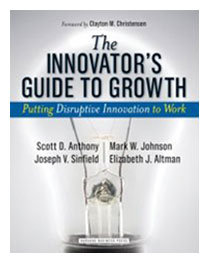 This post is part of the Post2Post Virtual Book Tour, my Innovise Guy pardner Doug Stevenson is also reviewing the book on The Innovise Guys Blog (the post-tour tour).
This post is part of the Post2Post Virtual Book Tour, my Innovise Guy pardner Doug Stevenson is also reviewing the book on The Innovise Guys Blog (the post-tour tour).
I do a bit of reading. I try to have one business book and one fictional book going at all times. This last month my pair has been The Innovator’s Guide to Growth and Salmon Rushdie’s Midnight’s Children. It has proved to be a month of intense learning about innovation — and India! The Innovator’s Guide to Growth, which I am reviewing here, I predict, will become as important a book in the business world as Rushdie’s Booker Prize winning novel is in fiction. Quite simply, IG2G is the new bible for innovation managers and leaders.
Business leaders: do not pass go, do not collect 200 stock options, go immediately to Amazon and buy this book. I haven’t read such an eye opener since picking up Geoffrey Moore’s Crossing the Chasm in the early 90’s.
Business books are often a slog to read. Even those with good content can be sleeping pill substitutes. IG2G is quite dense with information about how to “do” innovation — particularly disruptive innovation. However, it’s no sleeping aid, you are compelled to keep reading because it’s just so damn insightful, fresh, and filled with important advice on all aspects of the innovation puzzle.
I’ve been saying for some time that innovation is a holistic organizational activity; it’s not one thing it’s many intertwined factors. There is no silver bullet! Many business books address some aspect of it, call them silver-bullet-centric; virtually none are holistic in nature. IG2G is the exception, it’s womb-to-tomb about innovation management and process. It sorts out the complexity and removes the mystery for innovation leaders. It’s truly a guide — they didn’t use that word in the title just for the alliteration! Leaders take note: what they say in IG2G — the first chapter — there is no silver bullet for companies interested in enhancing their organization’s ability to innovate. IG2G is what managers really need, a full-process tool kit.
Speaking of titles, the subtitle of IG2G is — putting disruptive innovation to work. This is key because one of the great things about this book is how it clears up the concept of disruptive innovation. It presents a valuable and persuasive case as to why disruptive innovation is so essential for growth. Growth is the point of innovation after all isn’t it? In watching many organizations continue to extend product lines incrementally it’s clear that they are avoiding the risk of bigger, new-market type innovation. Innovation leaders often fall prey to what I call the Pete Rose trap, that is, settling for singles instead of swinging for the fences (note to international readers: forgive the baseball analogy, it means “not taking enough risk”). Falling for the Pete Rose trap means that organizations fail in the long run. IG2G gives leaders the tools they need to justify, plan, create, and execute a balanced innovation strategy that includes the all-important disruptive element. This book could save your company.
I love that the book is peppered with real world examples. For instance, it tells the story of Best Buy’s development of the Geek Squad service. It’s a great example of disruptive growth through acquisition and development. J&J, P&G, Dow Corning, and Intel are just a few of the many success stories cited to flesh out the books guidance. The team of author’s are Scott Anthony, Mark Johnson, Joseph Sinfield, and Elizabeth Altman. The men on the author team are all part of Innosight a premiere innovation consultancy that uses the concepts articulated in IG2G. Innosight owes a lot of its brilliance to Harvard professor Clayton Christensen, one of the founders, who has done much of the deep research that backs up this book. Indeed, he wrote the foreword to IG2G. Altman is a Motorola strategy executive and adds real world experience in innovation to this guidebook.
This is clearly a book written by experts who know all aspects of innovation. I was paying particularly close attention to what the authors said about how to do the creation part of innovation. Ideation is something I specialize in so I was hoping to catch them out on something! Instead, I read advice on ideation that I’ve been preaching (to mostly deaf ears) for years. I keep saying that ideation takes time, that it can’t all be done in one big brainstorming session. It made me feel good to read that they suggest that a team take several weeks developing and exploring opportunities. Amen brothers! They further suggest that if you do an ideation session you should combine fresh groups of people. Good suggestion. I would go one better and suggest you bring in folks from outside the organization and I’ll bet they would agree.
They are also quite insightful when it comes to on-going innovation idea programs. They believe that reinforcement is critical. This is so right, I’ve seen this time and again, where organizations ask for ideas, get thousands, then ignore them.
The only downside to IG2G is simply that it is, like Midnight’s Children, not a glazed doughnut to consume. It’s as dense as a bourbon laced holiday fruit cake — plan on reading it slowly, studying it really, for the next quarter. Perhaps with a nice port!



One response to “The Innovator's Guide to Growth…a new bible for Innovation Managers”
[…] program he’s suggesting. Anthony wrote another innovation book that I reviewed awhile back The Innovator’s Guide to Growth. This new book would appear to be less academic and more practically oriented. More on the book in […]